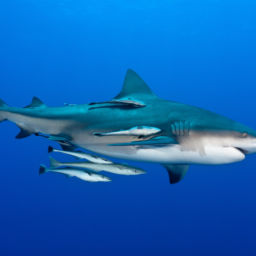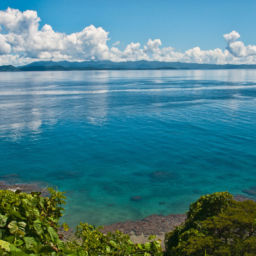You might think that “serene chaos,” sounds like an oxymoron, but I’ve witnessed it first hand in Fiji’s Beqa Lagoon. The reef, just 15 minutes by boat from Pacific Harbour on the south of main island Viti Levu, is famous as the site of a shark dive regularly touted as the best in the world.
I caught my first glimpse of Fiji from the airplane, and felt my excitement levels increase accordingly as I gazed across a fantasy landscape of lush, rolling mountains dressed in the emerald green of sprawling rainforest. In the days that followed, Fiji lived up to my first impressions, compounding them with crystal-clear seas, vibrant, thriving reefs, spectacular terrestrial scenery and the friendliest local people I’ve ever met. I drank kava, a ceremonial drink derived from a shriveled plant root; a Fijian woman befriended me and fed me breadfruit in her village home; I went freediving at a spectacular, secret outer reef known only to the local fishermen of Ovalau Island. By the time I finally reached Pacific Harbour, ready to dive with the sharks of Beqa Lagoon, I never wanted to leave.
I dove with Aqua-Trek, an operator that’s promoted shark conservation since pioneering the Beqa shark dive in the late 1990s. Joining us was Brandon Paige, the South African who first thought of using fish scraps from the local factories to draw big sharks to the lagoon. This simultaneously prevents their waste while creating one of Viti Levu’s biggest tourism draws, and also allows scientists to closely observe the sharks. It was fascinating to dive alongside someone with so many years of experience with Fiji’s sharks. The journey by boat to the dive site was short, although 15 minutes was still long enough for my excitement to reach a fever pitch by the time we were ready to enter the water.
Descending was like entering a parallel universe, designed to fulfill a shark lover’s ultimate fantasy. The ocean around us was clean and endlessly blue, although it was hard to tell exactly how far the visibility stretched due to the wall of fish spiraling in an impenetrable cloud around the bait drum below. Schools of snapper and fusiliers appeared in shades of shimmering blue, while convict-striped sergeant majors darted inquisitively through our group. Through the smaller fish prowled swarms of giant trevally, while the bright gold juveniles of the same species contrasted against the shadows of the depths below. Then, as we reached the seafloor at 82 feet, the real stars of the show appeared. The largest nurse sharks I’d ever seen joined the lemon sharks with their lustrous, iridescent skin. Of the eight species that can appear in the lagoon, I’d most wanted to see bull sharks, and finally, they arrived.
Around the feeding site, a low wall constructed of rock rubble separated the divers from the bait drum, a reutilized garbage can filled with discarded fish heads and manned by Brandon Paige and two specifically trained Fijian divemasters. As the sharks jostled for position, the feeders presented them with the heads, which they received with remarkable grace. To watch them was fascinating, and I soon realized how different each species was from the other by the way they fed. The nurse sharks surrounded the bait drum in a constant, insistent tangle, like dogs begging for scraps at the table; the bull sharks, despite their enormous size and fearsome reputation, were by far the most well-mannered dinner guests. With their considerable girth and disproportionately tiny eyes, raw power emanated tangibly from the 15 or so bulls circling around us, and yet each waited his turn at the bait drum according to a hierarchy known only to themselves.
We spent 20 minutes at the feeding site, and were lucky to witness the fleeting visit of a silvertip shark to the bait drum. According to the Fijian fishermen I’d spoken to on Ovalau, the locals are more wary of this species than of any other due to its pelagic nature and, consequently, opportunistic feeding habits. However, the one we saw was incredibly shy, arriving in a streak of silvered mercury and leaving just as fast upon having taken the bait proffered by one of the quick-reacting feeders. It felt tragic when our divemaster finally signaled that it was time to move into shallower water, but there was some compensation — an enormous Napoleon wrasse, more of the ever-hungry nurse sharks, a few grey reef sharks and one of my favorites, the whitetip reef shark. As the other divers in the group started to run low on air, they were escorted to the surface until eventually only my buddy, myself and our divemaster remained; just the three of us, and a shiver of swirling, circling sharks.
Whether or not to feed sharks in the name of creating shark encounters is a question that continues to spark heated controversy in the dive community, and one that I will not debate in this article. I will say that this particular dive impressed me beyond my greatest expectations. In Beqa Lagoon, divers and sharks can closely interact without any apparent negative consequences for either party, as evidenced by Aqua-Trek’s impeccable safety record and by the sharks, which were among the healthiest I’ve ever seen. Recognizing sharks as a valuable income source means that local Fijians have come to appreciate their presence, and the opportunity to see them in such close proximity enables scientists to conduct conservation research. Most importantly, this dive and others like it are invaluable in the fight to change the global perception of sharks for the better. On the day that I dived, most of the other visitors were apprehensive about entering the water, as sharks are so often portrayed as being dangerous to humans. In the end, however, an experience that may at first have seemed chaotic was in fact one of serenity, and when those same nervous divers returned to the boat they could not wait to repeat their encounter with the sharks of Beqa Lagoon.



